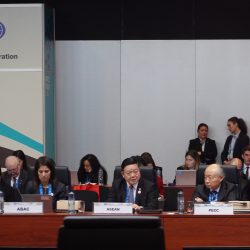In the corner of Indonesia’s 100,000 rupiah note, the eastern islands of Raja Ampat beckon with white sand beaches and lush jungle hills.
An archetype of tropical paradise, Raja Ampat’s coral reefscapes anchor one of the planet’s most biodiverse marine ecosystems, short-listed for UNESCO World Heritage status.
Yet the islands also contain rich mineral deposits eyed by Indonesia’s mining industry, seeking to produce battery-grade nickel in an expanding electric vehicle (EV) supply chain for lithium-ion batteries. The clash between conservation and resource extraction to meet the world’s decarbonisation goals is an ongoing struggle. Caught in between, indigenous Raja Ampat communities in Indonesia’s conflicted West Papua region risk losing their rights and self-determination.
As Indonesia lays the groundwork for EV-related infrastructure through vast industrial parks and new plans for a nickel smelter near Raja Ampat, conservationists and indigenous leaders fear the erosion of a growing economy centred on sustainable eco-tourism.
“Mining should be the last resort of economic development, not our first option,” said Charles Imbir, Raja Ampat’s elected member in the Papuan house of representatives. “People in Raja Ampat need to have a good livelihood and this development has to be sustainable. It must bring the local community stronger, and independence in terms of livelihood and social welfare.”
Formerly a Dutch colony, West Papua was annexed by Indonesia following a 1969 UN-endorsed referendum widely seen as illegitimate due to coercion from Indonesian authorities. Since then, simmering armed and nonviolent independence movements alike have been met with violence from the build-up of Indonesian security forces across Papua.
The region was split into three additional provinces earlier this year, which critics say diluted Papuan autonomy and will make it easier to rubber stamp regional resource extraction.
Efforts to reconcile the impact of climate change by advancing nickel production in West Papua deepens the impact on marginalised peoples further, said Anne-Linn Machielsen, a researcher at the Netherlands’ Delft University of Technology.
“It is a new way of continuing colonialism for green energy transitions,” said Machielsen, who wrote her thesis contextualising Raja Ampat’s nickel mining development. The green energy infrastructure in Raja Ampat is being “built on colonial structures.”
She noted a 2022 report from the Intergovernmental Panel on Climate Change acknowledged for the first time the role of colonialism in fueling global warming. Decolonisation should be an essential component to the green energy transition, meaning local communities like those in Raja Ampat must have control over how their own natural resources are used, Machielsen argued.
Otherwise, she said, green energy development in Papua amounts to “green colonialism.”

Raja Ampat is far from a static paradise lost in time. Home to seven different languages across a multitude of clans and tribes comprising 60,000 indigenous Papuans, the region was historically an important player in regional trading networks.
The island communities constantly evolved by incorporating new ideas and practices, most recently embracing eco-tourism tied to conservation, explains anthropologist Ian Parker.
“It’s a way of making claims on their own future by which they have a stake in negotiating jobs, bringing in outsiders to see how beautiful their village and the way that they live is,” Parker said. “To talk about conservation is to talk about hope for the future.”
Beginning in the early 2000s, a contingent of conservation NGOs, including World Wildlife Fund for Nature and Conservation International, worked with local communities to create 12 marine protected areas, encompassing nearly 14,000 square miles at the core of the Coral Triangle, an expanse of ocean home to the highest concentrations of coral on the planet.
Since Dutch colonialism, outside forces have coveted the region’s large nickel deposits, especially on the island of Gag, which contains just under 1% of the world’s nickel reserves. In 2018, the company PT Gag Nikel was given the greenlight to mine there through 2047.
Mining on small islands like Gag is technically illegal in Indonesia, but there are still 165 concessions across 55 small islands, including an estimated 13 concessions in West Papua, according to the Mining Advocacy Network (JATAM). The majority are nickel mines and owned by the government.
A 2006 report from Conservation International and the State University of Papua found the economic benefits of the region’s biodiversity were double the value of extracting the region’s minerals, given the destruction of reefs by mining run-off, whose sediment suffocates coral, and other mining-related impacts such as deforestation.

Yet a 2009 local government report countered that mining comprised more than 50% of local GDP and would “improve the welfare of the people of Raja Ampat” by offering “serious potential wealth.”
Today, local tribal leaders worry the planned smelter and increasing demand for nickel across Indonesia will trigger an expansion of mining in Raja Ampat. Trinitan Metals, the company behind the smelter, said it will get its nickel from Gag islands and hopes to expand its supply from other Raja Ampat islands, according to Trinitan executive Vony Yudha.
“Where there is a smelter, it opens a market. The seller will come because the buyer is already there,” said Torianus Kalami, a former city council rep and environmental activist from the Moei tribe. “Of course, it will encourage a lot of mining.”
PT Gag Nikel, which did not respond to requests for comment from the Globe, states on its website that it seeks to “minimise the environmental impact of mining activities” and monitors “samples of river water, soil and seawater and sea sand.”
“When you dive around those areas the reefs are dead,” said one Raja Ampat resident, who has worked with Conservation International and requested anonymity for security concerns. “They just extract minerals and they don’t care about the environment. It’s about as bad as you can do.”
A report from Indonesian media KOMPAS, which visited Gag in June 2021, found sediment darkening the sea bed and spoke with local residents who complained about loss of fishing grounds.
Local communities and tribal leaders are rarely involved in the mining process except for the beginning when the company seeks to entice them, said Kris Thebu, who, as head of the tribal council Ma’ya Dewan Adat, is the most powerful tribal leader in Raja Ampat.
“The local people never really get anything from it, they never know where the office is or who is in charge,” he said.
As of September, royalties from PT Gag Nikel have not yet been transferred to local communities, according to Papuan People’s Assembly representative Yulianus Thebu, who in contrast to his brother Kris, has spoken favourably of the company in local media. Yulianus, who visited Gag this year, said he believes there have been no serious environmental issues yet.
Other communities across Raja Ampat appear to have struggled against companies exploring and developing mining operations with little oversight due to Papua’s effective media black-out. Mining licences throughout Raja Ampat were reportedly acquired by bribes, and companies have stoked tribal divisions to secure access to resources. Another company left massive deforestation and gaping, open pits after it ended operations.

On one Raja Ampat island, east Waigeo residents said another nickel mining company PT. Anugrah Surya Pratama (ASP), refused to release its environmental impact assessment, leading community members to blockade its office.
“PT. ASP really does not respect the rights of indigenous peoples, does not respect the environment,” locals told a now-defunct Papuan newspaper in 2013. “[PT ASP] will be dangerous in the future for the people who are in the mining area by extracting the wealth of the community…”
The company still actively controls the mining concession.
The companies behind the proposed smelter claim in their promotional materials and interviews that it will be at the vanguard of sustainable EV battery production in Indonesia, seeking to supply Japanese, Korean and western companies such as Taelim Corp and Britishvolt.
Trinitan Metals has declared its smelter will produce “zero waste” thanks to a still-untested novel technology, but this is highly unlikely, said Steve Emerman, a geophysicist who evaluates mining projects. The smelter’s projected 17 tonnes of carbon dioxide emitted per tonne of nickel processed was also “way above the trends in the nickel mining industry,” he said.

Sorong Special Economic Zone (SEZ) Director Gabriel Hasahatan Simanjuntak, said the smelter, scheduled to run in 2024, will employ 3,500 local people and offer vocational training for indigenous Papuans.
But Simanjuntak acknowledged indigenous Papuan communities had not yet been consulted nor had an environmental impact assessment been conducted. Tribal leaders from the Moei tribe, who live around the SEZ, said they had not been informed of the smelter, its potential impact or employment opportunities.
“Investment in Papua only benefits people in Jakarta, the people who own the business,” said Kalami, the former Sorong city councillor and member of the Moei tribe. “The investment will not bring justice to the local people.”
Mining in West Papua is inseparable from an expansion of political and military power, said university of Queensland researcher Jason Macleod. He recalls visiting Gag Island and discovering PT Gag Nikel had used funds earmarked for community development to build a police outpost.
Local tribal leaders and regional Papuan leadership councils may have a token say in development processes, but the reality is these decisions are made by the national government, said Cammi Webb-Gannon, an anthropologist at the University of Wollongong.
PT Gag Nikel, like many mining companies across Indonesia, has ties to PT Anneka Tambang (known as ANTAM), the state-owned mining company and the nation’s largest producer of nickel, whose leadership includes a retired army general.
“A genuine process of dialogue [with local communities] can’t take place because it happens in a coercive environment,” Macleod said. “Not only do you have a government that is not representative of the aspirations of people, you have the constant presence of the Indonesian security forces, police and military, who have a vested interest in the outcome of these kinds of decisions.”
The push for UNESCO status could safeguard Raja Ampat even from these powerful interests. While Indonesia placed Raja Ampat on its “tentative list” in 2003 for consideration as a World Heritage site, the government has yet to formally submit a nomination, according to a UNESCO spokesperson.
Whether or not their islands receive UNESCO status, Raja Ampat’s tribal and elected local leaders say a conservation economy, rather than resource extractive push, is the future of their region.
“If you want to develop the Papuan people it is pretty easy — you need to have concern for the wellbeing of the Papuan people,” said Thebu, the leader of Raja Ampat’s tribal council.
“Mining has never given any contribution to the local people.”





















Discussion about this post